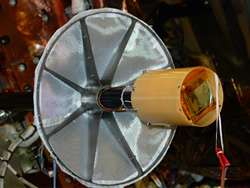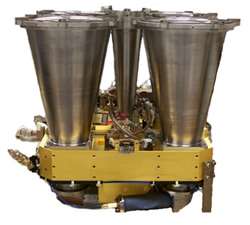Mercury-bound Goddard Instruments Aboard MESSENGER Arrive at Target

As the MESSENGER spacecraft begins its science operations above the surface of Mercury, Goddard instruments are gearing up to help unveil the planet's mysteries. Goddard leads or co-leads two of the spacecraft's instruments and a science investigation aboard the spacecraft.
The vector fluxgate Magnetometer, or MAG, is a joint development between NASA's Goddard Space Flight Center in Greenbelt, Md., and the Johns Hopkins University Applied Physics Laboratory in Laurel, Md.
MAG will collect magnetic field samples at a rate of up to 20 times per second. These measurements will be used to discover the nature and origins of the planet’s global magnetic field, determine the magnetic properties of its outer layer or crust, and explore new types of space weather that are thought to be unique to Mercury.
For example, the dynamic interaction between the very strong flux of charged particle radiation from the Sun at 0.31 Astronomical Units (AUs) and Mercury's magnetic field is believed to be responsible for the huge day-to-day variations in this planet's atmosphere. Mercury’s atmosphere is very tenuous and is believed to exist in part due to the sputtering of neutral atoms off the surface by solar wind ions that enter through "holes" in the shield created by this planet’s magnetic field.

The Mercury Laser Altimeter (MLA), led by Goddard, will map the planet's landforms and other surface characteristics. At the heart of the instrument are a laser that sends light to the planet's surface and a sensor that gathers the light that has been reflected back from the surface. By measuring the amount of time it takes for light to travel to the surface and back, the distance to the surface can be calculated. These distance measurements are taken eight times per second, roughly 500 yards apart on the surface, yielding very accurate descriptions of the topography, or contours, of Mercury's landscape.
Goddard also leads the Radio Science (RS) investigation. The observations are gathered by tracking the spacecraft via the communication system. Using the Doppler effect, the Radio Science experiment will measure very slight variations in MESSENGER's speed and distance from Earth. These will help scientists understand how the planet's mass is distributed, including details such as variations in the thickness of Mercury's crust.
MLA data combined with the Radio Science investigation will help map the planet's gravitational field and provide information about the size and characteristics of Mercury's core.
MESSENGER (MErcury Surface, Space ENvironment, GEochemistry, and Ranging) is a NASA-sponsored scientific investigation of the planet Mercury and the first space mission designed to orbit the planet closest to the Sun. The MESSENGER spacecraft launched on August 3, 2004, and after flybys of Earth, Venus and Mercury, will start a yearlong study of its target planet in March 2011. Dr. Sean C. Solomon, of the Carnegie Institution of Washington, leads the mission as Principal Investigator. The Johns Hopkins University Applied Physics Laboratory built and operates the MESSENGER spacecraft and manages this Discovery- class mission for NASA.
Provided by JPL/NASA




















